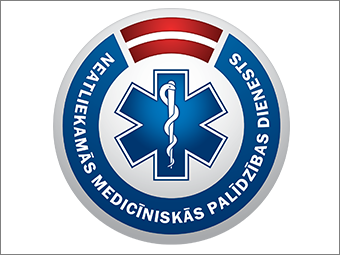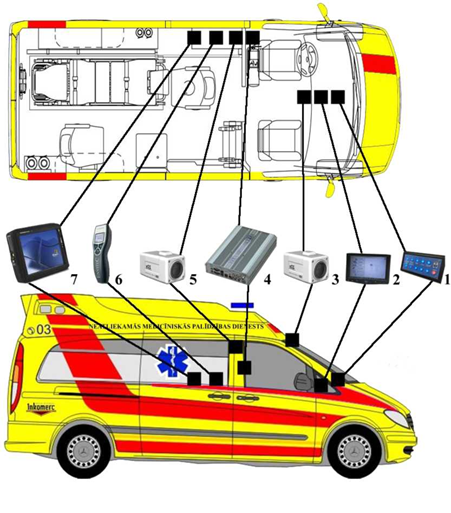
The customer of the system: the Emergency Medical Service of Latvia.
Purpose of the system: providing emergency (within 15-20 minutes) qualified medical care to a person located anywhere in the territory of the Latvian Republic.
The project is implemented and successfully works for more than seven years. The development of the project continues.
The main modules of the system are:
1. Dispatching received calls: appointment, management of ambulance teams, control of the execution of tasks:
- Authorization: – for the dispatch service employees this procedure is mandatory and ends with the receipt of an admission to work from the shift supervisor.
- Making a call, appointment of a brigade: A call from a person in need of medical care is accepted and formalized by the dispatcher of the call reception in the “Call Centre” – ambulance service. After that, the calling card is electronically transmitted by the dispatcher to the brigade in the ambulance for execution.
2. Monitoring the work of teams directly in ambulances:
- Authorization: – Entering the password of the head of the brigade, alcohol control, this procedure is mandatory for the entire ambulance brigade, is carried out at the moment the brigade arrives for work. In the computer memory photos and titles with data from the meter are uploaded. Further, the bag with medicines is monitored, as well as the general condition of the machine. The brigade leader confirms the readiness of the brigade’s work by pressing a special key on the screen. The result of authorization is confirmation by the dispatcher of the status message “The team is ready for work”. The test is completed, the data is sent to the archive.
- Call execution: – the dispatcher automatically receives from the system the data on the nearest location of the team with the corresponding qualification specialization and sends an electronic calling card to the machine. The card appears simultaneously both on the terminal of the doctor and the terminal of the driver and is on the screen until it is fully executed. After the brigade makes a call, the dispatcher is automatically sent a status message – “Call accepted”. At the driver’s terminal, the route to the patient’s location is automatically constructed. The voice guidance of the navigation system is activated, and the driver follows to the place of the event. When the brigade arrives at the address, the “Arrived at address” status message button is pressed at the terminal, the “Patient Call Card” appears again in the driver’s terminal instead of the geographic map, as well as new buttons with status messages: – “At the patient”, “Hospitalization”, “The brigade is free “,” Return to the substation. ” These keys are used as soon as they are accepted and coordinated with the solution dispatcher.
To organize the work of the team on the terminals of the doctor and the driver, the following virtual buttons are available:
“The exact time” is synchronized with the time of the ambulance service;
“Call records” are only calls made by this team during the current day;
“Information” is a link to a database of the service in which to find information relating to the tasks directly performed by the team;
“Navigation” – this is the ability to search for the location of the desired object and build a route;
“Video” – control of the front and salon video camera, dispatch to the dispatcher from the side of the car video and audio materials.
3. Technical (computer) equipment of brigades in ambulances:

The main control module of the system is the multifunctional on-board computer SmartCar and the SmartGuard terminal manufactured by our company (see the section “Products”).
1. Portable communication brigade terminal:
- Autonomous work (without the use of an on-board computer, read more in the “Products” section). This device can move with the team outside the vehicle and keep in touch with the dispatcher, while the dispatcher controls the location of the brigade on the map, as well as the status of the call execution;
- 2. driver’s terminal allows:
- Get on the screen a call card of the patient, including the motive of the disease,
the patient’s location, - navigation – automatic voice guidance along the route to the place of the event;
- Exchange of status messages between the dispatcher and the team;
- Constant video and audio control of execution of a call by the dispatcher;
- Direct two-way communication with the dispatcher from the monitor screen;
- Sending an alarm signal to the dispatcher from the monitor screen;
- Archiving of the electronic call log;
3. Video camera (front)
- Video recording of call execution (traffic, parking);
- Video recording of the scene, the ability to approach from 0.5 km to 30 meters the scene of the accident (disaster) for decision making;
- Sending video fragments to the dispatcher for decision making. The dispatcher, if necessary, can, at his discretion, remotely control the camera and monitor the situation around the ambulance, qualified specialists (for example, in the car the paramedic brigade turned out to be).
4. Video camera installed in the car’s interior
- It is possible to record and remotely monitor the execution of procedures for rescuing the patient;
- Sending video fragments to the dispatcher for decision making.
- possibility to remote assisting rescue procedures with highly skilled specialists (for example, a paramedic brigade in the car).
5. The onboard computer
- Maintenance of all external devices of the system, their integration into a single information environment, as well as processing and sending data from a set of medical equipment to the dispatcher (cardiograph, defibrillator, oxygen supply system, etc.)
- Provides control over the operation of all electronic devices and units inside the machine, including flashing beacons, sirens, etc .;
- A high degree of accuracy of control is provided, and uniform time correction in the entire ambulance service, including transport;
- Unified cartographic support is provided, both in the terminals of the machine and in the dispatch services;
- Automatically monitors the quality of all wireless communication channels, choosing the most productive in the region for data transfer.
- Automatically supports continuous communication of all terminals with the dispatcher;
- If necessary can transfer all the necessary information about the patient to the hospital’s reception room, in order to speed up the processing of materials for the operation.
6. Alkometer
- Remote control of the state of the brigade, compulsory use in the authorization of the brigade before starting work (on duty);
- Controlling the level of alcohol intoxication of the victim.
7. Monitor (terminal, tablet possible)
- Authorization of the brigade upon arrival on duty;
- Acceptance of a calling card for execution;
- more detailed information from the service about the patient (contraindications, data from the family doctor, etc.);
- Processing call cards, filling in graphs, including a report on used drugs, sending the card to the dispatcher;
- Control and transmission of status messages;
- Sending an alarm signal to the dispatcher from the monitor screen.
More information You can get by e-mail.

